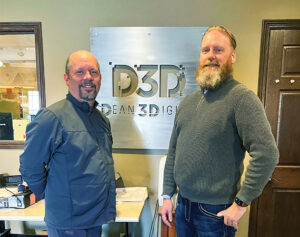Clint Link, principal of North Branch Area High School, turned heads at the regional rollout of Enterprise Minnesota’s 2023 State of Manufacturing® in North Branch when he discussed the proactive role of public education in the future of Minnesota’s manufacturers. Link has been principal at North Branch since 2022. Before that, he served in several positions in the Waseca Public Schools district beginning in 2000 — including as a teacher, director of innovation and career pathways, and girls’ basketball coach. Link received a degree in secondary education from the University of North Dakota and a master’s degree from Saint Mary’s University. “My entire education career is built on creating systems and content that allow learners to first better understand the world around them but second, to see their futures in it,” he says. “The world around us is constantly changing. How we teach and learn needs to reflect that.”
Describe your tech-oriented evolution as an educator.
Clint: I was a high school social studies teacher. I started drifting from traditional teaching methods when I saw how Chromebooks provided tools for more independent learning. So, I started learning and teaching a little bit differently. I eventually left the classroom to teach teachers how to leverage technology to personalize education for kids with different backgrounds and skill sets.
I moved from just technology into career pathways as career and technical education evolved. High schools went away from career tech ed in the late ’90s because reading and math standardized tests — and later science — were being pushed on schools. So, we put our resources into those spaces. But labor markets were looking for students with skilled-based understanding. When I moved to North Branch as a principal, I found a growing district that shared my vision. We have the facilities and the postsecondary partners to execute it. I think we are what the modern high school should be.
Parents understand that most kids don’t need a four-year postsecondary path. I worked in Waseca for 20 years of my career. Sixty percent of jobs in that region required a certification or a two-year degree. Only 20% of those jobs required a four-year degree, but we still had 80% of our graduates going to four-year institutions. They were becoming educated and under-skilled for the labor market — and they were also getting severely in debt.
How meaningful is the relationship between secondary schools and tech schools?
Clint: It’s essential. We need each other. At the high school level, I need a postsecondary partner with the resources — either teachers or equipment — to help kids get higher levels of skill training in areas like industrial, machining, welding, or auto courses. These are very expensive courses to run. We have several postsecondary partners like Pine Tech, in our case, that have equipment and have those teachers. And then it’s up to us to be creative in how we partner together. Do we share equipment for a duration of time? Do they bring a trailer to our campus so that we can use some equipment for a period of time? Do we do tours? Can kids work at night up there? It’s a good partnership: They need our students to go into their pathway, and we need their skilled training and equipment.
What about the relationship with manufacturers?
Clint: The Perkins V Federal Grant for Career and Technical Education helps us supplement the associated expenses and requires that we have an advisory board composed of more than 50% of industry partners. Those industry partners help guide what and how we’re teaching kids and give us a direct partnership in resources. For example, our local Ford dealership Anderson & Koch helped us get a free curriculum for our auto classes. And the more we use that curriculum, the more equipment that comes to us at no cost. Our advisory committees also help the work-based learning program. Those internships help them evaluate the talent pipeline of new entry-level workers who could move right out of high school and into their field.
You’re fairly bullish about how North Branch is progressing on all of this. What’s your vision for how that educational process might evolve?
Clint: My vision for this school is built around a concept called “Choice, not Chance” that I used as a basketball coach. We have choices every day that directly influence our future. Once high school kids understand how things they do now will impact their future — and how those things are within their control — then it’s up to me and our staff to provide them with relevant opportunities. Those choices are going to evolve with what the industry needs.
The second part is called the Big Blur, a concept that blends the high school setting and post-secondary classes with work-based learning. I see that scaling out more in the next five years: More kids taking college-level courses in career and technical education and more kids leaving school during the day to do internships, externships, or apprenticeships. So, when they leave high school, they feel confident about whatever education choices they need to make to start their professional career faster.
Return to the Summer 2024 issue of Enterprise Minnesota® magazine.


